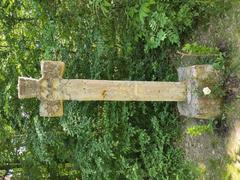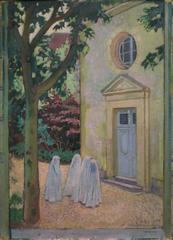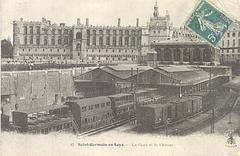Pavilion of Angoulême Visiting Hours, Tickets, and Travel Guide in Saint-Germain-en-Laye
Date: 14/06/2025
Introduction
The Pavilion of Angoulême, set in the historic town of Saint-Germain-en-Laye, is a remarkable testament to France’s royal and architectural legacy. Though it now survives largely through partial remains and historical documentation, its story weaves through centuries of regal heritage, shifting aesthetics, and cultural transformation. This comprehensive travel guide covers the Pavilion’s historical context, how to visit, what to expect at the site today, practical visitor information, and tips to enrich your experience in Saint-Germain-en-Laye.
Explore the château grounds—now home to the National Archaeology Museum—stroll the formal gardens, and discover the enduring allure of the Pavilion of Angoulême, whether you are a history buff, architecture enthusiast, or a curious traveler. For official visitor details, see the National Archaeology Museum and Saint-Germain-en-Laye tourism portal.
Table of Contents
- Introduction
- Historical Overview and Architectural Significance
- The Pavilion Today: Remains and Site Context
- Visiting Information
- Visitor Experience
- Preservation and Cultural Programs
- Frequently Asked Questions (FAQ)
- Conclusion & Planning Resources
- References
Historical Overview and Architectural Significance
Origins and Royal Associations
The Pavilion of Angoulême was intricately linked with the Château de Saint-Germain-en-Laye and the Valois dynasty. Constructed during the French Renaissance under François I—himself born François d’Angoulême—the pavilion represented the transition from medieval fortifications to refined royal residences (discoverwalks.com). The château complex evolved over centuries, witnessing expansions, renovations, and the tastes of successive monarchs.
The pavilion’s very name evokes its royal connections, referencing the Angoulême family line. It was not only a site of courtly life but also a symbol of the artistic and political shifts that shaped French history (INHA - Institut National d’Histoire de l’Art).
Architectural Features and Evolution
The Pavilion of Angoulême showcased Renaissance architecture, with balanced proportions, ornate plasterwork, brick-and-stone polychrome façades, and generous windows. Its location afforded sweeping views of the estate’s gardens, which were later redesigned by André Le Nôtre in the 17th century (culturezvous.com).
In the late 18th century, the pavilion underwent a neoclassical transformation under Louis Charles Guy, secretary to the Comte d’Artois. Architect Antoine François Peyre’s design incorporated a distinctive rotunda, rare conical roof, and an artificial grotto. Elements salvaged from the neighboring Château-Neuf, dismantled after the Revolution, further embedded the pavilion’s narrative within France’s changing fortunes (Monumentum).
The Pavilion Today: Remains and Site Context
Surviving Structures and Heritage Status
The Pavilion of Angoulême does not exist today as a complete, independent building. Most of the original structure was lost to renovations and urban changes, especially in the 19th and 20th centuries. However, the rotunda and artificial grotto—now protected as a Monument Historique—remain visible at 6 rue Girauld Teulon, in the old town of Saint-Germain-en-Laye (POP – Monument Historique listing).
These remnants, featuring neoclassical stucco motifs, a rare conical roof, and romantic rockwork, offer a unique glimpse into the pavilion’s aesthetic legacy and the broader cultural history of the area.
Gardens and Surroundings
The former site of the Pavilion, along with the main château, is set amid the grand Le Nôtre-designed gardens and expansive parklands. The terraces provide panoramic views over the Seine Valley and towards Paris. The château exterior and gardens are a living memory of the Renaissance spirit that once defined the estate (culturezvous.com).
Visiting Information
Visiting Hours
- Château and Gardens: Open daily from 8:00 AM to sunset, free entry year-round.
- National Archaeology Museum (in the château): Open Tuesday to Sunday, 10:00 AM – 6:00 PM; closed Mondays and select holidays (National Archaeology Museum).
- Pavilion of Angoulême (rotunda/grotto): No interior access; external viewing from public streets is available at any time.
Tickets and Admission
- Gardens: Free entry.
- Museum: Adult ticket ~€7, reduced rates for students/seniors, free for children under 18 and EU residents under 26. Tickets available online or at the entrance.
- Pavilion: No ticket required for exterior viewing; site is not open for interior visits.
Accessibility
- Château & Gardens: Wheelchair-accessible paths, ramps, and adapted facilities. Some historic sections may have limited access.
- Pavilion Area: Pedestrian-friendly zone; exterior can be viewed from the street. No interior access due to preservation status.
- Visitor Facilities: Accessible restrooms and parking; assistance dogs permitted.
Travel Tips and Nearby Attractions
- Getting There: RER A train from Paris to Saint-Germain-en-Laye (approx. 30 minutes), then a short walk to the château and old town.
- Address: Place Charles de Gaulle (château), 6 rue Girauld Teulon (pavilion), 78100 Saint-Germain-en-Laye.
- Parking: Limited near the château; public transport is recommended.
- Nearby: Explore the historic town center, local markets, Château de Saint-Germain-en-Laye, Le Nôtre gardens, and panoramic terraces. Seasonal events, concerts, and exhibitions are often held on the château grounds (Saint-Germain-en-Laye events).
Visitor Experience
Guided Tours and Interpretation
- Château/Museum: Guided tours (primarily in French; inquire for English) provide insights into the estate’s history and its lost pavilions. Booking in advance is recommended.
- Pavilion: No regular tours; some heritage walks may include the site. Brochures and digital guides are available at the château.
- Interpretation: Museum exhibitions occasionally feature digital reconstructions or references to the Pavilion of Angoulême and other lost estate features.
Photography and Artistic Highlights
- Château/Gardens: Photography is permitted outdoors; flash/tripods may be restricted inside the museum.
- Pavilion: The rotunda’s conical roof and neoclassical details are excellent photo subjects from the street.
Preservation and Cultural Programs
As a designated Monument Historique, the Pavilion’s rotunda and grotto are under state protection (POP – Monument Historique listing). The National Archaeology Museum and local authorities support ongoing conservation, occasional exhibitions, and educational activities, ensuring the site’s legacy endures.
Frequently Asked Questions (FAQ)
Q: Can I visit the Pavilion of Angoulême interior?
A: No, interior access is not permitted; visitors may view and photograph the exterior from public areas.
Q: Are there remains of the original pavilion?
A: Only the rotunda and grotto survive; most of the original structure has disappeared.
Q: Do I need a ticket to see the Pavilion?
A: No ticket is needed for exterior viewing; museum entry requires a ticket.
Q: Are guided tours available?
A: Guided tours focus on the château/museum; some heritage walks may include the Pavilion area.
Q: Is the site accessible for people with disabilities?
A: The surrounding area is largely accessible; interior access to the pavilion is not possible.
Q: Can I take photos?
A: Yes, outdoor photography is allowed; restrictions may apply inside the museum.
Conclusion & Planning Resources
While the Pavilion of Angoulême no longer stands in its original grandeur, its remnants and the surrounding estate offer a window into the evolution of French royal architecture and cultural heritage. The Château de Saint-Germain-en-Laye and its gardens provide a captivating setting to reflect on this history. Plan your visit by checking current opening hours, ticket options, and event schedules.
For more destination ideas and in-depth guides, download the Audiala app and follow us on social media for updates and curated itineraries.
References and Official Links
- Top 10 Historical Facts about Château de Saint-Germain-en-Laye (Discover Walks)
- Cultural Getaway: Saint-Germain-en-Laye (Culturez Vous)
- Saint-Germain-en-Laye Sightseeings (Places and Things To Do)
- Official Tourism Website of Seine Saint-Germain
- Musée d’Archéologie Nationale (Culturez Vous)
- Saint-Germain-en-Laye Official Site
- National Archaeology Museum Official Website
- Monument Historique Listing – POP
- Monumentum detailed historical entry
- Saint-Germain-en-Laye municipal agenda
- France Voyage - Saint-Germain-en-Laye tourism
- SoloSophie Paris Day Trips: Saint-Germain-en-Laye




